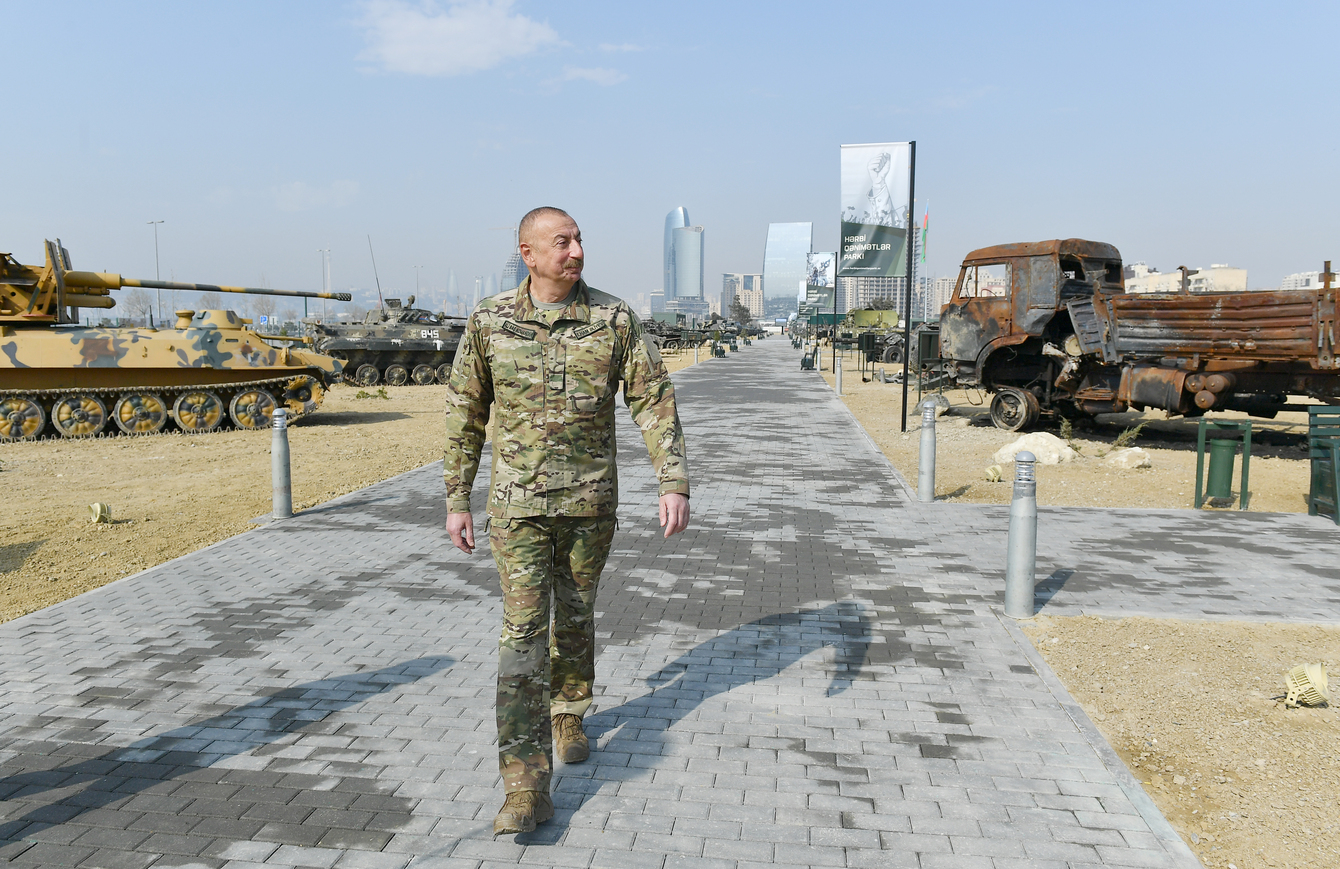Dozens of military equipment of Armenia, which were destroyed and captured during a war with Azerbaijan in the latter's Karabakh region last year, went on display on Monday at a new theme park in Azerbaijan’s capital city of Baku.
The military equipment is being showcased in the “Military Trophy Park” on a territory approximately the same size as ten football pitches along the shores of the Caspian Sea near the city center.
President Ilham Aliyev, who inaugurated the park, said the demonstrated equipment that has been destroyed and captured by the Azerbaijani army once again demonstrates the strength of Azerbaijan and the defeat of Armenia.
“The equipment on display here is a small part of the destroyed and seized equipment of the enemy. [Some] 125 artillery cannons, 366 tanks, 7 S-300 anti-aircraft missile systems, more than 50 other anti-aircraft missile systems, 522 trucks, and other equipment were destroyed and taken as trophies,” the president said.
Armenia and Azerbaijan have been at odds for decades over the Karabakh (Garabagh) region, which is internationally recognized territory of Azerbaijan. In 1991, Armenia kicked off military aggression against Azerbaijan to occupy the region. The full-scale war lasted until a ceasefire deal in 1994. As a result, Armenia occupied 20 percent of Azerbaijan’s internationally recognized territories. Over 30,000 ethnic Azerbaijanis were killed and one million were expelled from those lands in a brutal ethnic cleansing policy conducted by Armenia.
The latest outbreak of war in the region started on September 27 last year after Armenia’s forces deployed in the occupied Azerbaijani lands shelled military positions and civilian settlements of Azerbaijan. The attacks triggered the Azerbaijani forces to take immediate counter-offensive measures for pushing back the assault. The war ended in a tripartite ceasefire statement signed on November 10 by Armenia, Azerbaijan, and Russia. By this time, Azerbaijani forces liberated more than 300 settlements, including the cities of Jabrayil, Fuzuli, Zangilan, Gubadli, and Shusha, from nearly 30-year-long illegal Armenian occupation. Armenia also returned the occupied Aghdam, Kalbajar, and Lachin districts to Azerbaijan by December 1 as part of the obligations it took under the ceasefire deal.
The war inflicted heavy military equipment losses on Armenia. The total cost of the Armenian army's military equipment destroyed and captured by the Azerbaijani forces during the war stood at $5 billion. Armenia's weapons destroyed and captured by the Azerbaijani forces in the battles include 366 tanks, 116 infantry fighting vehicles, 352 cannons of various calibers, 125 mortars, 522 trucks, 103 specialized vehicles, as well as 5 Su-25 attack aircraft, 4 “Smerch” heavy multiple rocket launchers, 2 "Elbrus" tactical-operational missile systems, 97 “Grad” truck-mounted multiple rocket launchers, 7 “S-300” anti-aircraft missile system launchers, 40 “OSA” air defense systems, 22 unmanned aerial vehicles, and many more.
A part of the military trophies was earlier showcased at the Victory Parade in Baku on December 10, 2020. The parade included D-30 and D-20 cannons, T-72 tanks, UAZ Patriot and UAZ Hunter armored vehicles, Ural and KamAZ trucks, BM-21 Grad complexes, and more.
A theme park dedicated to military trophies is not one of its kind in Europe. Uniforms, firearms, and even parachutes of the Nazi officers have been put on display in the museums in the Netherlands and Denmark. In Russia, there is a Victory Museum, which displays both the captured vehicles and weapons along with the military hardware of the Soviet army and its allies from World War 2.







 The number of evacuees from flooded areas in Kazakhstan has reached 97,852 people, including about 32,856 children since March 27.
The number of evacuees from flooded areas in Kazakhstan has reached 97,852 people, including about 32,856 children since March 27.
 The Islamic holy month of fasting, Ramadan comes to an end this week with the celebration of a joyous festival called Eid (meaning “festival” in Ar...
The Islamic holy month of fasting, Ramadan comes to an end this week with the celebration of a joyous festival called Eid (meaning “festival” in Ar...
 Iran's senior military leaders described the drone and missile attack on Israel on April 14 night as “successful".
Iran's senior military leaders described the drone and missile attack on Israel on April 14 night as “successful".
 Iranian President Ebrahim Raisi warned Israel that it would face a "real and extensive" response if it makes any "mistake" following Tehran’s missi...
Iranian President Ebrahim Raisi warned Israel that it would face a "real and extensive" response if it makes any "mistake" following Tehran’s missi...



